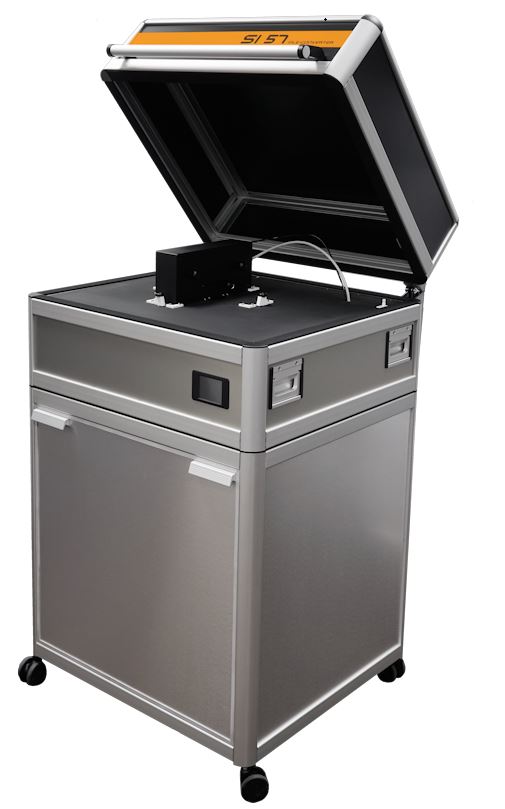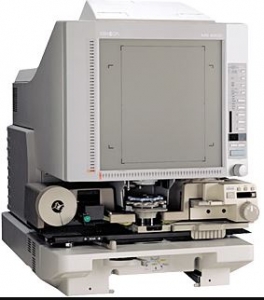A microfilm machine is an equipment used in the microform industry. To most people, it means the microfilm reader you have probably seen at your local library. But it is more than this.
While some machines are used to write microfilm, others are used to visualize microfilm, such as microfilm readers. To scan microfilm you use a microfilm scanner and to process microfilm you will use a specially designed film processor.
What is a microfilm machine and what we use it for
Microfilm machine can mean different things. Microfilm machine stands for an equipment that can produce, read or digitize microfilms. It usually means an equipment involved in the microfilm industry. As with everything, such a machine has different uses.
We use it at different levels in the microfilming process. Our team uses special microfilm writers to produce microfilm. You can process that film with a microfilm processor to reveal the information on the film. Of course, we do need to inspect that film for quality issues. For example, we use a combination of a densitometer and microfilm viewer for that.
Then we have the customers which already have the film but they need digital copies. Here comes the microfilm scanner. It will digitize both 16mm and 35mm film. In the end, come the storage systems. While it might seem as plain furniture, the microfilm storage systems are becoming more advanced.
The 5 main categories of microfilm machine
There are 5 basic types of microfilm machines. The difference between them is that each serves one process in the microfilm industry. Practically each has a different purpose.
For example, we have machines that produce microfilm. On the other hand, we have machines that digitize information on microfilm. So it all depends what is the need of a customer at a specific moment.
The microfilm archive writer
Yes indeed, we are talking about microfilm writers. Such writers burn information to film. They literally burn the film in the shape of the information. The process is quite interesting and it never ceases to amaze you.
You have an information source, which is usually a led bar or a screen. Then we have a lens, that projects the information to film. And of course the film, which is the support on which information is exposed. The combination of lens and led bar provides the desired reduction on film.
Furthermore, we have the alternatives of choosing 16mm or 35mm film. There are machines which can do both. But all of them use different camera units. So swap one for the other as needed. Difference between using a screen or a led bar helps in achieving grayscale film. Although with RGB led we might find led based writers pretty soon.
The microfilm processor
Once burned, the film needs to be processed. The processing stage involves quite an interesting setup. First of all, you will need a water supply.This should have a water heater attached to it. The heater will then be adjusted to the specifications of the processing machine.
For the actual processing phase, you will need special chemicals. Furthermore, we recommend you adapt quantities based on specifications. Based on the film, you will require different quantities. The developer is the chemical that aids the information revealing phase.
The film will suddenly become transparent on margins and reveal your information. While this sounds good, you then need to fix the image on film. For this we use fixing chemicals, usually called a fixer. The fixer stabilizes the image on film as mentioned.From the fixer, the film is washed and then dried. Sounds simple but it gets complicated sometimes.
The equipment to use for inspection of microfilm
As mentioned in other articles we do need to inspect the processed film. The delay between processing and inspection has to be very short.This means we can react quickly to any problems that might give us hard times. First of all, you will need a densitometer to check for the density of black.
Based on film type and documents you process, you will have different target values. Make sure you calibrate the machine often enough. To check the calibration value, you should use strips of color with standard values. The strip has a predetermined color value. So the densitometer, if well calibrated, should always show that value.
The second machine you need is a viewer. The viewer allows for quick checks of film. You should usually check for scratches or lint on film. This usually means something is not good in the processing machine.
The microfilm reader and printer
We use different machines to view microfilm. I guess it all depends on why you are reading microfilm.In our case, we use it for microfilm inspection. We make sure the writing and the processing are working according to the standards. Others use them for the actual consultation of microfilm.
Whether it’s archives or libraries, if they have microfilms they also microfilm viewers in the reading room. Based on what you do with the machine, you will pick a certain model or manufacturer. For example, some readers want to be able to print pages from microfilm.
That is why manufacturers have developed viewer connected to printers directly. You browse through the pages and select the frames you need to print. These machines are usually low-end microfilm scanners. While they don’t have the speed or the quality of professional ones, they are good enough for basic tasks.
The microfilm scanner
As we’ve talked in other articles, you can split microfilm scanners into user and professional. The user-based scanner is as called, based on the user needs. These needs are fairly basic. It will provide better quality and higher speed than a standard viewer. But at the same time, you won’t be able to use it for mass conversion.
As time passes, even the user based equipment is getting quicker and quicker. We have seen this with every model coming out. But high production machines still provide the best value for money, when large volumes are involved. The actual processing speed is immense.
Both the physical scanning speed and the digital processing speed are backed up by good hardware and software. Rotation and image polarity are done on a fly. The same for Sharpness, contrast, and brightness. These are high production machines for very busy environments.
Conclusions on the usage of microfilm machines
- As mentioned earlier, a microfilm equipment is built for specific tasks. One will not do everything, it will only handle a task.
- The microfilm writer is the microfilm machine you need for the 1st phase of microfilm production.
- Once you write the film, you will need a microfilm processor to reveal what you have written.
- We recommend you inspect the film after processing. Use a densitometer and a viewer to check for any issues.
- If you are a library or an archive and have microfilm, install readers in the reading room. Users will find the entire process easier.
- If you have microfilm and want to digitize it, use microfilm scanners. For lower quantities use a low-end scanner. It will be enough.
- Mass microfilm digitization requires high-end microfilm scanners. Otherwise, your project might take ages and not meet quality standards.
We recommend the following guide to see how microfilming was done in the older days.
Also, you can check more about microfilming or about scanning microfilms in our other articles.[/fusion_text]








